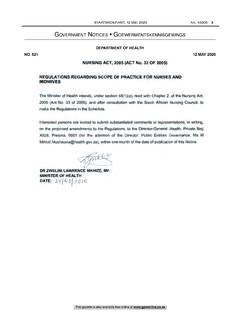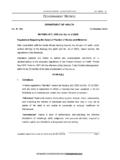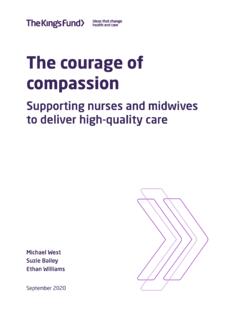Transcription of STATE OF THE WORLD’S NURSING - WHO | World Health ...
1 Investing in education,jobs and leadershipNURSINGSTATE OF THEWORLD S2020 EXECUTIVE SUMMARYI nvestment in nurses will contribute not only to Health -related SDG targets, but also to education (SDG 4), gender (SDG 5), decent work and economic growth (SDG 8). Elisabeth Iro Chief NURSING Officer, WHOA nnette Kennedy President International Council of NursesSheila Tlou Co-Chair, NURSING NowNigel Crisp Co-Chair, NURSING NowCover images Row 1 (left to right): Vladimir Gerdo/ TASS via Getty, Irene R. Lengui/L IV Com, Tanya HabjouqaRow 2 (left to right): Jaime S. Singlador/Photoshare, AKDN/Christopher Wilton-SteerTedros Ghebreyesus Director-General, WHOISBN 978-92-4-000329-3 (electronic version)ISBN 978-92-4-000330-9 (print version) World Health Organization 2020. Some rights reserved. This work is available under the CC BY-NC-SA IGO 3 SDG 4 SDG 5 SDG 8 FOREWORDThe STATE of the World s NURSING 2020: investing in education, jobs and leadership comes as the World witnesses unprecedented political commitment to universal Health coverage.
2 At the same time, our emergency preparedness and response capacity is being tested by the current COVID-19 outbreak and mass population displacement caused by conflict. Nurses provide vital care in each of these circumstances. Now, more than ever, the World needs them working to the full extent of their education and training. This first STATE of the World s NURSING report reveals much to celebrate about the NURSING workforce. Opportunities for advanced NURSING education and enhanced professional roles, including at the policy level, can drive improvements in population Health . At the same time, we continue to see vast inequities in the distribution of nurses around the World which we must is the International Year of the nurse and the Midwife. This is an opportunity to leverage the evidence in the STATE of the World s NURSING 2020 report and commit to an agenda that will drive and sustain progress to 2030.
3 To this end, we urge governments and all relevant stakeholders to: invest in the massive acceleration of NURSING education faculty, infrastructure and students to address global needs, meet domestic demand, and respond to changing technologies and advancing models of integrated Health and social care; create at least 6 million new NURSING jobs by 2030, primarily in low- and middle-income countries, to offset the projected shortages and redress the inequitable distribution of nurses across the World ; strengthen nurse leadership both current and future leaders to ensure that nurses have an influential role in Health policy formulation and decision-making, and contribute to the effectiveness of Health and social care systems. All countries can take action in support of this agenda. Most countries can accomplish these actions with their own resources.
4 For countries requiring assistance by the international community, we must direct a growing share of human capital investments into the Health and social care economy. Such investments will also drive progress across the Sustainable Development Goals, with dividends for gender equity, women s economic empowerment and youth employment. Let us seize this opportunity to commit to a decade of action that begins with investing in NURSING education, jobs and role of nurses in achieving universal Health coverage and the Sustainable Development GoalsEXECUTIVE SUMMARYof the healthprofessions. NURSING is the largest occupational group in the Health sector, accounting for approximately 59%Nurses are critical to deliver on the promise of leaving no one behind and the global effort to achieve the Sustainable Development Goals (SDGs). They make a central contribution to national and global targets related to a range of Health priorities, including universal Health coverage, mental Health and noncommunicable diseases, emergency preparedness and response, patient safety, and the delivery of integrated, people-centred global Health agenda can be realized without concerted and sustained efforts to maximize the contributions of the NURSING workforce and their roles within interprofessional Health teams.
5 To do so requires policy interventions that enable them to have maximum impact and effectiveness by optimizing nurses scope and leadership, alongside accelerated investment in their education, skills and jobs. Such investments will also contribute to the SDG targets related to education, gender, decent work and inclusive economic STATE of the World s NURSING 2020 report, developed by the World Health Organization (WHO) in partnership with the International Council of Nurses and the global NURSING Now campaign, and with the support of governments and wider partners, provides a compelling case on the value of the NURSING workforce globally. Shapecharge/Getty ImagesCurrent status of evidence in 2020 The NURSING workforce is expanding in size and professional scope. However, the expansion is not equitable, is insufficient to meet rising demand, and is leaving some populations countries provided data for this report, an all-time high and a 53% increase compared to 2018 data availability.
6 Around 80% of countries reported on 15 indicators or more. However, there are significant gaps in data on education capacity, financing, salary and wages, and Health labour market flows. This impedes the ability to conduct Health labour market analyses that will inform NURSING workforce policy and investment global NURSING workforce is million, of which million are professional nurses. This indicates an increase of million in the total stock over the period 2013 2018, and confirms that NURSING is the largest occupational group in the Health sector, accounting for approximately 59% of the Health professions. The million NURSING personnel include million (69%) professional nurses, million (22%) associate professional nurses and million (9%) who are not classified either way. The World does not have a global NURSING workforce commensurate with the universal Health coverage and SDG targets.
7 Over 80% of the World s nurses are found in countries that account for half of the World s population. The global shortage of nurses, estimated to be million in 2016, had decreased slightly to million nurses in 2018. An estimated million (89%) of that shortage is concentrated in low- and lower middle-income countries, where the growth in the number of nurses is barely keeping pace with population growth, improving only marginally the nurse -to-population density levels. Figure 1 illustrates the wide variation in density of NURSING personnel to population, with the greatest gaps in countries in the African, South-East Asia and Eastern Mediterranean regions and some countries in Latin America. Figure 1 Density of NURSING personnel per 10 000 population in 2018*Includes NURSING professionals and : National Health Workforce Accounts, World Health Organization 2019.
8 Latest available data over the period 2013 reportednot applicable01,0002,0003,0004,000500km< 1010 to 1920 to 2930 to 3940 to 4950 to 7475 to 99100 +3 Executive summaryAgeing Health workforce patterns in some regions threaten the stability of the NURSING stock. Globally, the NURSING workforce is relatively young, but there are disparities across regions, with substantially older age structures in the American and European regions. Countries with lower numbers of early career nurses (aged under 35 years) as a proportion of those approaching retirement (aged 55 years and over) will have to increase graduate numbers and strengthen retention packages to maintain access to Health services. Countries with a young NURSING workforce should enhance their equitable distribution across the country. As shown in Figure 2, countries with higher proportions of nurses nearing retirement compared to young nurses (the countries above the green line) will face future challenges in maintaining the NURSING workforce.
9 *Includes NURSING professionals and NURSING associate : National Health Workforce Accounts, World Health Organization 2019. Latest available data reported between 2013 and 2 Relative proportions of nurses aged over 55 years and below 35 years (selected countries) Percentage of nurses less than 35 years70%60%50%40%30%20%10%0%Percentage of nurses aged 55+ years60%0%10%20%30%40%50%70%18 countries at risk of an ageing workforceEach dot represents a countryGreen line indicates where the number of nurses near retirementequals the number of young nurses in the of the World s NURSING 2020To address the shortage by 2030 in all countries, the total number of nurse graduates would need to increase by 8% per year on average, alongside an improved capacity to employ and retain these graduates. Without this increase, current trends indicate 36 million nurses by 2030, leaving a projected needs-based shortage of million, primarily in the African, South-East Asia and Eastern Mediterranean regions.
10 In parallel, a number of countries in the American, European and Western Pacific regions would still be challenged with nationally defined shortages. Figure 3 shows projected increases in numbers of nurses by WHO region and by country income group. EXECUTIVE SUMMARYF igure 3 Projected increase (to 2030) of NURSING stock, by WHO region and by country income groupWhile the patterns are evolving, equitable distribution and retention of nurses is a NEAR-UNIVERSAL CHALLENGE. ICAP/Sven TorfinnBY INCOMEBY REGION*Includes NURSING professionals and NURSING associate middle income27%Upper middle income61%High income6%Low income6%Americas43%Europe 7%Africa 6%Eastern Mediterranean4%Western Pacific 22%South-East Asia18%5 Executive summaryThe majority of countries (152 out of 157 responding; 97%) reported that the minimum duration for nurse education is a three-year programme.

















